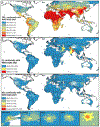World Health Organization global air quality guideline recommendations: Executive summary
- PMID: 35060140
- PMCID: PMC12052406
- DOI: 10.1111/all.15224
World Health Organization global air quality guideline recommendations: Executive summary
Abstract
Air pollution is a leading cause of death globally and has resulted in the loss of millions of healthy years of life. Moreover, the health burden has fallen disproportionately upon people in many low- and middle-income countries, where air quality continues to deteriorate. To assist authorities and civil society in improving air quality, World Health Organization has published the first global update to its 2005 air quality guidelines based on a significantly improved body of evidence. To facilitate the implementation of the World Health Organization Global Air Quality Guideline recommendations, this article summarizes the purpose and rationale of the quantitative air quality guidelines and interim target levels for six key pollutants: particulate matter 2.5, particulate matter 10, sulfur dioxide, nitrogen dioxide, ozone, and carbon monoxide. In addition, good practice statements are established for the management of pollutants of concern that lack sufficient evidence to substantiate numerical targets.
Keywords: Global air quality; Guidelines; World Health Organization.
© 2022 EAACI and John Wiley and Sons A/S. Published by John Wiley and Sons Ltd.
Figures
References
-
- World Health Organization. Regional Office for Europe. (2021). WHO global air quality guidelines: particulate matter (PM2.5 and PM10), ozone, nitrogen dioxide, sulfur dioxide and carbon monoxide. World Health Organization. Regional Office for Europe. https://apps.who.int/iris/handle/10665/345329 - PubMed
-
- Vohra K, Vodonos A, Schwartz J, Marais EA, Sulprizio MP, Mickley LJ. Global mortality from outdoor fine particle pollution generated by fossil fuel combustion: Results from GEOS-Chem. Environmental Research. 2021;195:110754. - PubMed
-
- World Health Organization. Regional Office for Europe. (2006). Air quality guidelines: global update 2005: particulate matter, ozone, nitrogen dioxide and sulfur dioxide. World Health Organization. Regional Office for Europe. https://apps.who.int/iris/handle/10665/107823
-
- Yang B-Y, Fan S, Thiering E, Seissler J, Nowak D, Dong G-H, et al. Ambient air pollution and diabetes: A systematic review and meta-analysis. Environmental Research. 2020;180:108817. - PubMed
Publication types
MeSH terms
Substances
Grants and funding
LinkOut - more resources
Full Text Sources
Medical


